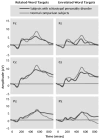Semantic dysfunction in women with schizotypal personality disorder
- PMID: 12359685
- PMCID: PMC2845844
- DOI: 10.1176/appi.ajp.159.10.1767
Semantic dysfunction in women with schizotypal personality disorder
Abstract
Objective: This study examined whether early or late processes in semantic networks were abnormal in women with a diagnosis of schizotypal personality disorder. The N400 component of the EEG event-related potentials was used as a probe of semantic processes.
Method: Word pairs were presented with short and long stimulus-onset asynchronies to investigate, respectively, early and late semantic processes in 16 women with schizotypal personality disorder and 15 normal female comparison subjects. Event-related potentials were recorded in response to the last words in a pair.
Results: With the short stimulus-onset asynchrony, the N400 amplitude was less negative in the schizotypal personality disorder group than in the normal comparison group. No group differences were found with the long stimulus-onset asynchrony.
Conclusions: The finding of a less negative than normal N400 amplitude with the short stimulus-onset asynchrony in women with schizotypal personality disorder supports the hypothesis that persons with this disorder evince an overactivation of semantic networks. The absence of group differences with the long stimulus-onset asynchrony, which is primarily sensitive to processes involved in context integration, suggests that in this group of schizotypal personality disorder subjects, additional demands on working memory may be necessary to bring out the semantic dysfunction.
Figures



Similar articles
-
An event-related brain potential study of schizotypal personality and associative semantic processing.Int J Psychophysiol. 2010 Feb;75(2):119-26. doi: 10.1016/j.ijpsycho.2009.10.005. Epub 2009 Oct 8. Int J Psychophysiol. 2010. PMID: 19818815 Free PMC article.
-
Event-related brain potential study of expectancy and semantic matching in schizotypy.Int J Psychophysiol. 2014 May;92(2):67-73. doi: 10.1016/j.ijpsycho.2014.02.006. Epub 2014 Mar 4. Int J Psychophysiol. 2014. PMID: 24607603
-
Electrophysiological correlates of language processing in schizotypal personality disorder.Am J Psychiatry. 1999 Jul;156(7):1052-8. doi: 10.1176/ajp.156.7.1052. Am J Psychiatry. 1999. PMID: 10401451 Free PMC article.
-
Semantic activation and verbal working memory maintenance in schizophrenic thought disorder: insights from electrophysiology and lexical ambiguity.Clin EEG Neurosci. 2008 Apr;39(2):103-7. doi: 10.1177/155005940803900217. Clin EEG Neurosci. 2008. PMID: 18450179 Free PMC article. Review.
-
N400 in schizophrenia patients.Curr Opin Psychiatry. 2013 Mar;26(2):196-207. doi: 10.1097/YCO.0b013e32835d9e56. Curr Opin Psychiatry. 2013. PMID: 23340116 Review.
Cited by
-
Quantifying incoherence in speech: an automated methodology and novel application to schizophrenia.Schizophr Res. 2007 Jul;93(1-3):304-16. doi: 10.1016/j.schres.2007.03.001. Epub 2007 Apr 16. Schizophr Res. 2007. PMID: 17433866 Free PMC article.
-
Identification of Neurophysiological Markers of Verbal Information Processing Using Cognitive Evoked Potentials for Studying Schizophrenia Spectrum Disorders.Sovrem Tekhnologii Med. 2022;14(6):53-61. doi: 10.17691/stm2022.14.6.06. Epub 2022 Nov 28. Sovrem Tekhnologii Med. 2022. PMID: 37181282 Free PMC article.
-
An event-related brain potential study of schizotypal personality and associative semantic processing.Int J Psychophysiol. 2010 Feb;75(2):119-26. doi: 10.1016/j.ijpsycho.2009.10.005. Epub 2009 Oct 8. Int J Psychophysiol. 2010. PMID: 19818815 Free PMC article.
-
Endophenotypes in schizophrenia: a selective review.Schizophr Res. 2009 Apr;109(1-3):24-37. doi: 10.1016/j.schres.2009.01.016. Epub 2009 Feb 15. Schizophr Res. 2009. PMID: 19223268 Free PMC article. Review.
-
Abnormal pitch mismatch negativity in individuals with schizotypal personality disorder.Schizophr Res. 2009 May;110(1-3):188-93. doi: 10.1016/j.schres.2008.10.017. Epub 2009 Mar 27. Schizophr Res. 2009. PMID: 19327968 Free PMC article.
References
-
- Bleuler E. In: Dementia Praecox or the Group of Schizophrenias. Zinkin J, translator. Vol. 1911. New York: International Universities Press; 1950.
-
- Andreasen NC. Thought, language, and communication disorders, I: clinical assessment, definition of terms, and evaluation of their reliability. Arch Gen Psychiatry. 1979;36:1315–1321. - PubMed
-
- Rochester SR, Martin JR. Crazy Talk: A Study of the Discourse of Schizophrenic Speakers. New York: Plenum; 1979.
-
- Shenton ME, Solovay MR, Holzman PS. Comparative studies of thought disorder, II: schizoaffective disorder. Arch Gen Psychiatry. 1987;44:21–30. - PubMed
-
- Harvey PD. Speech competence in manic and schizophrenic psychoses: the association between clinically rated thought disorder and cohesion and reference performance. J Abnorm Psychol. 1993;92:368–377. - PubMed
Publication types
MeSH terms
Grants and funding
LinkOut - more resources
Full Text Sources
Medical

